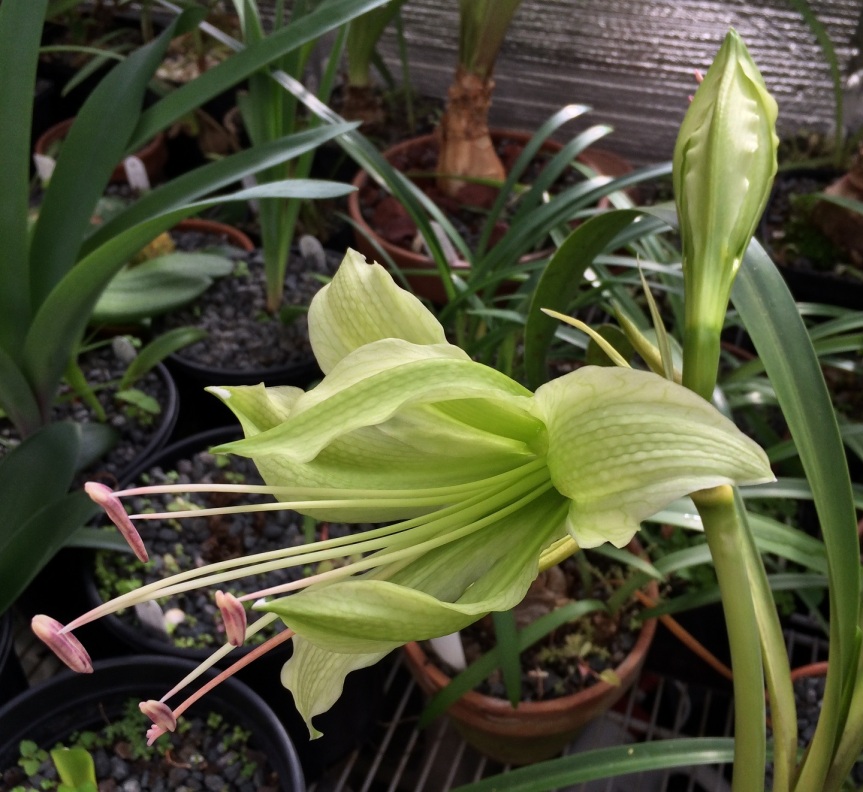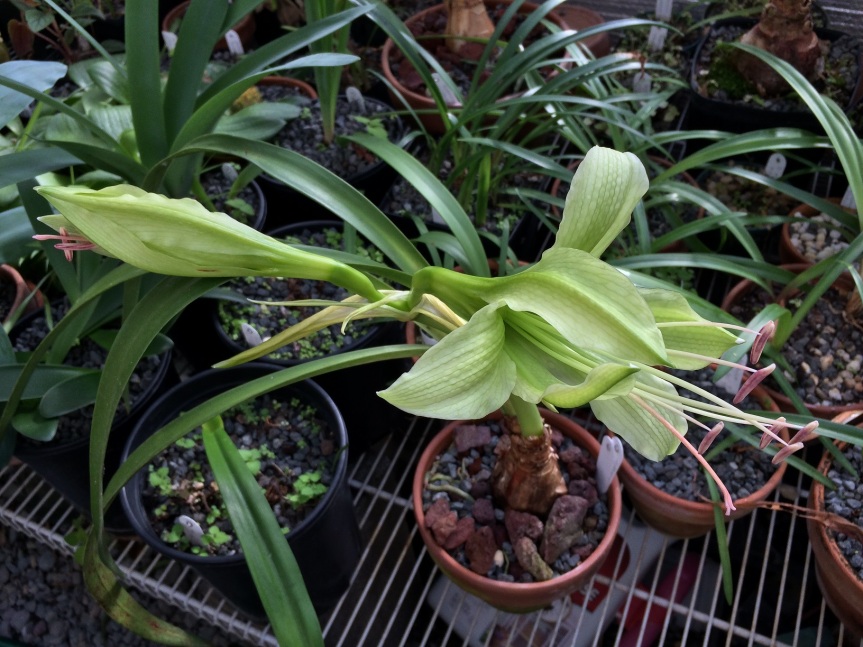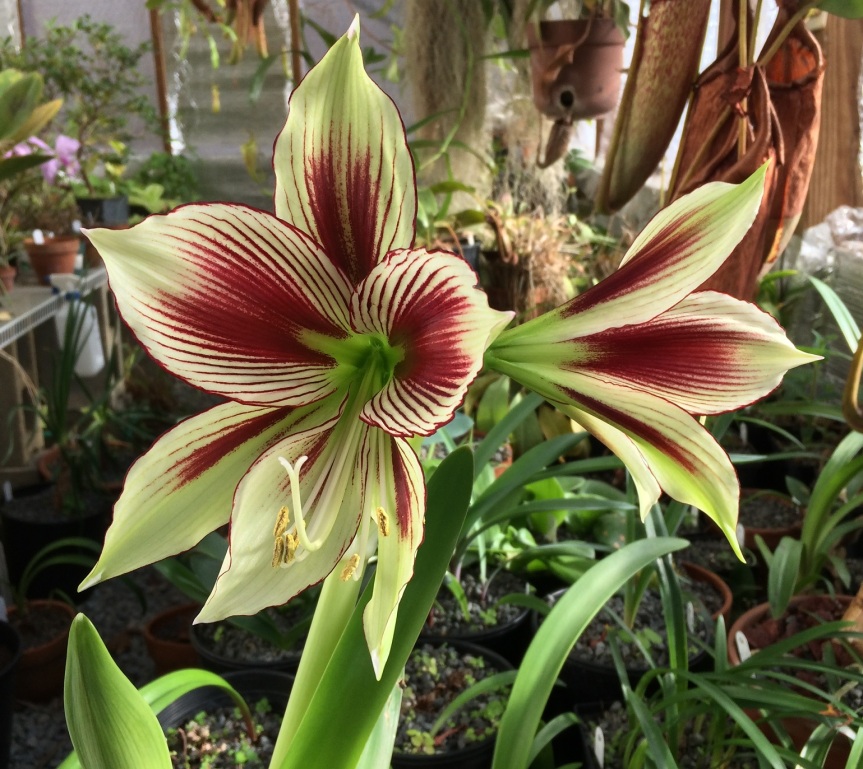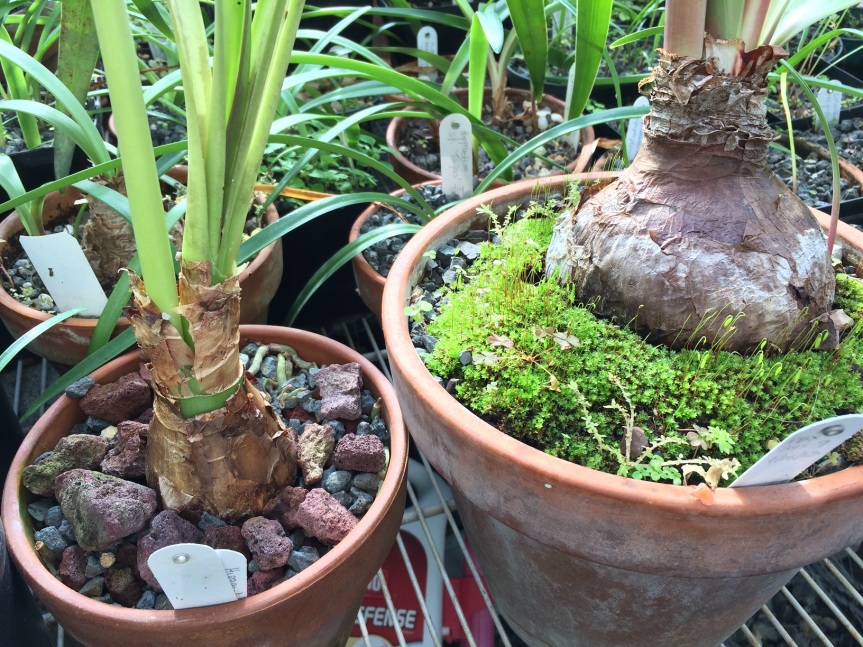
It’s frigid outside, but with a little help from LP gas (OK, a lot of help), it’s the tropics in my greenhouse. This week, the star is a seed-grown Hippeastrum calyptratum bulb, flowering for the first time four years after germination.
H. calyptratum is a very unusual amaryllid from the Atlantic Forest of southern Brazil, where it grows as an epiphyte on tree trunks. The pale green flowers are pollinated by bats and are often reported to produce a odor like burning plastic. To my nose, they smell more like wet paint, but the fragrance is not very strong–at least not from this seedling.

There are two (possibly three) other epiphytic Hippeastrum species. I previously posted on H. aulicum when my plants bloomed in autumn. The third epiphytic species, H. papilio is currently blooming a few feet away from the H. calyptratum, and a different clone bloomed earlier, at the same time as my H. aulicum.

The fourth epiphyte, H. arboricola, is rather mysterious. It was apparently described from a single plant found growing on a fallen tree in a clear-cut forest and has not been seen since. It is not clear if H. arboricola represents a distinct epiphytic species, possibly now extinct, or if it was a terrestrial species that was growing opportunistically on a tree.
H. aulicum and H. papilio are large, robust plants, very easy to grow in a mix of commercial potting soil and permatill (stalite). When I tried that mix with H. calyptratum, the plants did well initially but later lost their roots. In some cases, the entire basal plate rotted, destroying the bulb. I now use a very open, wholly inorganic mix of scoria (red lava rock) and permatill in terracotta pots and have much better results. As befits an epiphyte, I plant the bulb high in the pot, with just a few large chunks of scoria holding it in place. The roots are quite happy to wander around on the surface of the mix.

Assuming that my blooming plant is close to full size, the bulbs of H. calyptratum seem to be significantly smaller than those of H. aulicum and H. papilio, and the leaves are proportionally shorter and narrower. H. calyptratum shares with its larger epiphytic cousins a growth cycle that is quite different than that of the Hippeastrum (“Amaryllis”) hybrids sold for forcing in winter. H. calyptratum has a short dormancy in mid-summer, but it retains some of its leaves and does not want to be bone dry for long periods while dormant. As temperatures cool in autumn, my plants begin growing again, and they continue producing new leaves intermittently through the winter.

Epiphyitic plants are just weird. I just can not imagine a forest that is so crowded that plants do not have enough room to grow in the ground, or that they need to cling to trees to compete for sunlight. There is even an epiphytic yucca, Yucca lacandonica!
LikeLiked by 1 person
Beautiful! It’s so grey here, it’s a lift to the spirits to see such colourful blooms.
LikeLiked by 1 person
hi nick, i think H. reticulatum is also an epiphyte from the atlantic rainforest.
LikeLiked by 1 person
Hmm, I’ll have to do some reading. My understanding was that H. reticulatum grows in sandy soil.
LikeLike
Trying to determine if Hippeastrum calyptratum is self fertile. Any idea on that?
LikeLike
Not sure. I have bloomed two plants but didn’t try to self them. I was waiting until the bulbs were larger. H. aulicum and H. papilio certainly are self-fertile, so I think there’s a good chance H. calyptratum is too.
LikeLike
I’ve pollinated a number of times, but found the seed pod develops and then shrivels up. I recall reading somewhere online not self fertile. Are you saving your pollen? I would swap with you, yours for mine. But not til next blooming, I’ve had 2 bloomings in the last few months. Unusual I think. But using an awesome micro fertilizer that seems to make all my plants happy.
LikeLike
I didn’t save any pollen but will make a note to do so in future. At this point, I don’t expect any more flowers until next autumn.
LikeLike
That would be great, if you could save some pollen. I’ll do the same with mine later in the fall. Thanks
LikeLike
Very interesting. I just learned that Papilio is epiphytic and was wondering if I could grow it in lava rock. I might have to try that. I have had mine in potting soil for several years and it just doesn’t do all that will and it only bloomed for the the first year when I got it.
LikeLiked by 1 person
It’s worth a shot, if it isn’t doing well. You might also try a mix of potting soil with a lot of perlite or similar inorganic material.
LikeLike
Yes, I thought about trying a potting soil and inorganic mix. I have 4 offshoots on my original bulb, so I might divide them all and try a few different mediums to see which works best for me.
LikeLiked by 1 person